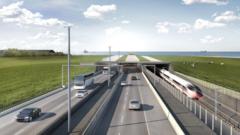The 18km (11 miles) long Fehmarnbelt tunnel promises to halve travel times between Copenhagen and Hamburg, offering a more sustainable transport option.
**Record-Breaking Baltic Sea Tunnel Set to Revolutionize Travel Between Denmark and Germany**

**Record-Breaking Baltic Sea Tunnel Set to Revolutionize Travel Between Denmark and Germany**
A groundbreaking engineering project under the Baltic Sea aims to transform connectivity between Denmark and Germany.
The tunnel being constructed beneath the Baltic Sea is set to be a landmark achievement in infrastructure, connecting Denmark and Germany in a way that has never been done before. The Fehmarnbelt project will become the world's longest pre-fabricated road and rail tunnel, measuring 18 kilometers (11 miles) and significantly slashing travel times across one of Europe’s busiest transport corridors.
Located predominantly at its northern entrance on Lolland island, Denmark, the construction site spans a vast area of 500 hectares and includes a factory dedicated to manufacturing the essential tunnel segments, termed "elements." According to Henrik Vincentsen, CEO of Femern, the state-owned entity overseeing the project, the facility is tremendous and plays a critical role in the tunnel's completion.
Each tunnel section will be made from reinforced steel, encased in concrete, measuring 217 meters (712 feet) in length and 42 meters wide. Unlike many underwater tunnels that are constructed by boring through bedrock, this one will approach assembly as though stacking Lego blocks, with 90 individual segments being painstakingly connected under the sea.
With a hefty budget of around €7.4 billion (about $8.1 billion), mainly funded by Denmark and supplemented by €1.3 billion from the European Commission, this project represents one of the largest infrastructure investments in the region. As part of a broader EU strategy to enhance travel links while minimizing carbon footprints, the tunnel will drastically reduce the journey from Rødbyhavn in Denmark to Puttgarten in Germany to just 10 minutes by car or 7 minutes by train—as opposed to the current 45-minute ferry ride.
The tunnel will feature a total of five parallel tubes, equipped with two train lines and two road lanes, as well as a maintenance corridor. This new infrastructure will not only connect Denmark to Germany but also facilitate easier travel between Scandinavia and central Europe, ultimately cutting carbon emissions by about 160 kilometers per trip.
Inside the site, senior construction manager Anders Gert Wede guides tours through parts of the tunnel structure. He describes the impressive size of the steel doors that securely hold back the sea and the complex process of transporting the heavy elements to their final underwater positions.
Constructing an immersed tunnel was deemed more practical and safe compared to an above-water bridge, which had originally been considered. Concerns over the potential for ship collisions with a bridge and considerable wind impacting traffic led to this innovative solution. Construction was significantly delayed by environmental concerns raised by local advocacy groups, but after a 2020 court ruling, work resumed as plans for ecological subsidies were integrated into the project.
Once completed in 2029, the tunnel is projected to handle over 100 trains and 12,000 cars daily, with the costs of construction expected to be recouped through tolls over a period of approximately 40 years. The ambitious endeavor is anticipated to bolster job opportunities and economic growth in Lolland— a region historically facing economic hurdles—as local communities eagerly await its completion.
Located predominantly at its northern entrance on Lolland island, Denmark, the construction site spans a vast area of 500 hectares and includes a factory dedicated to manufacturing the essential tunnel segments, termed "elements." According to Henrik Vincentsen, CEO of Femern, the state-owned entity overseeing the project, the facility is tremendous and plays a critical role in the tunnel's completion.
Each tunnel section will be made from reinforced steel, encased in concrete, measuring 217 meters (712 feet) in length and 42 meters wide. Unlike many underwater tunnels that are constructed by boring through bedrock, this one will approach assembly as though stacking Lego blocks, with 90 individual segments being painstakingly connected under the sea.
With a hefty budget of around €7.4 billion (about $8.1 billion), mainly funded by Denmark and supplemented by €1.3 billion from the European Commission, this project represents one of the largest infrastructure investments in the region. As part of a broader EU strategy to enhance travel links while minimizing carbon footprints, the tunnel will drastically reduce the journey from Rødbyhavn in Denmark to Puttgarten in Germany to just 10 minutes by car or 7 minutes by train—as opposed to the current 45-minute ferry ride.
The tunnel will feature a total of five parallel tubes, equipped with two train lines and two road lanes, as well as a maintenance corridor. This new infrastructure will not only connect Denmark to Germany but also facilitate easier travel between Scandinavia and central Europe, ultimately cutting carbon emissions by about 160 kilometers per trip.
Inside the site, senior construction manager Anders Gert Wede guides tours through parts of the tunnel structure. He describes the impressive size of the steel doors that securely hold back the sea and the complex process of transporting the heavy elements to their final underwater positions.
Constructing an immersed tunnel was deemed more practical and safe compared to an above-water bridge, which had originally been considered. Concerns over the potential for ship collisions with a bridge and considerable wind impacting traffic led to this innovative solution. Construction was significantly delayed by environmental concerns raised by local advocacy groups, but after a 2020 court ruling, work resumed as plans for ecological subsidies were integrated into the project.
Once completed in 2029, the tunnel is projected to handle over 100 trains and 12,000 cars daily, with the costs of construction expected to be recouped through tolls over a period of approximately 40 years. The ambitious endeavor is anticipated to bolster job opportunities and economic growth in Lolland— a region historically facing economic hurdles—as local communities eagerly await its completion.





















